If you’ve been following my blog over the past week, you’ve seen my writing on SCA5, Senate Constitutional Amendment 5 being advanced in California to attempt to repeal Proposition 209, which passed in the mid 90’s and took effect in 1998 on the UC admissions process.
There continues to be a lot of numbers flying around, and a lot of is being interpreted really bizarrely. The most significant problem with the numbers being quoted back and forth is that most are citing on-campus student demographics as either whole numbers or as fractions of state population. These numbers either completely ignore changes in overall population size (and thus applicant pool size), or are using Census data as proxies for that number.
Yet, the most appropriate numbers to use isn’t enrollment data, or state-wide population numbers: it is admission and application data from the UC school system. Enrollment data is complicated by the additional factor of student choice — which can be influenced by things like scholarship availablity, geographic locale, and major offerings — so it’s largely irrelevant to the debate of affirmative action in college admissions. State-wide population numbers fail to fully address the fact that in regards to college admissions, changes in population size are only relevant insofar as they produce an increase in applicant number.
So, again, to set the record straight, here is the impact of Proposition 209 on UC admissions and campus diversity. All numbers were crunched from this report, which was released by the UC office of the president (UCOP).
The UCOP report published application, admission, and enrollment data for the entire UC system for the last 22 years for in-state residents.
Application numbers are the entire number of applicants to the UC system, or individual campuses, by race. Admission numbers are the entire number of admitted students to the UC system, or individual campuses, by race. Admission rate is the percentage of admitted students by race compared to the number who applied (the latter of which is your best measure for assessing the impacts of population growth in the state).
Consistent with reports that population of virtually all races in California grew over this period, there was a steady increase in applicant number between 1990-2013 across all races.
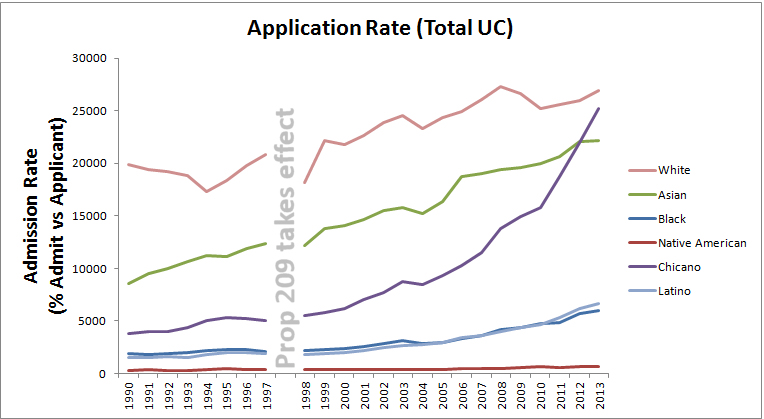
So what was the impact of Prop 209 on admission rate by race? Whereas prior to Prop 209, admission rate for students regardless of race was a relatively linear, and hovered at a reasonable 75-80%, you can see an immediate stratification of admission rates following Prop 209.
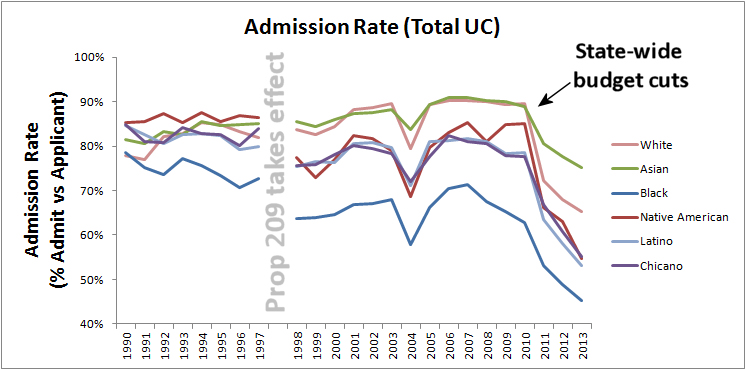
Many have cited growth in number of on-campus Asian Americans and Whites following passage of Prop 209 as evidence of the bias of affirmative action against these groups; they forget that this growth is largely explained by increases in population size leading to increases in applicant pool. But, when we look at admission rate, we can see the actual impact of Prop 209 on college admission decisions. Whereas Asian and White admission rates remain largely where they were prior to Prop 209 — and more importantly not significantly increasing — there is a precipitous drop in admission rate for Black, Latino and Native American students that persists for the subsequent 15 years.
To hammer that point home, here is the change in admission rate for all races between 1997 (when affirmative action was in place) and 1998, when Prop 209 took effect.
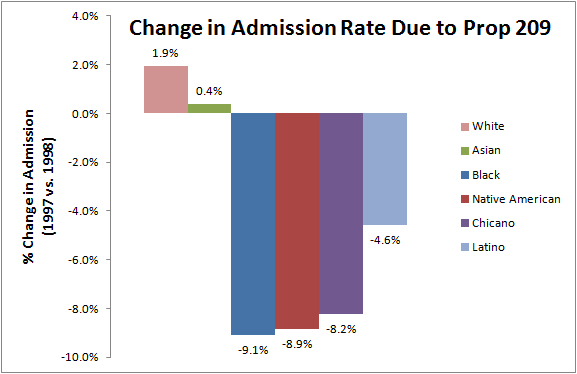
The effect of Prop 209 has had an even more pronounced impact on UC Berkeley, which is the “crown jewel” of the UC system.
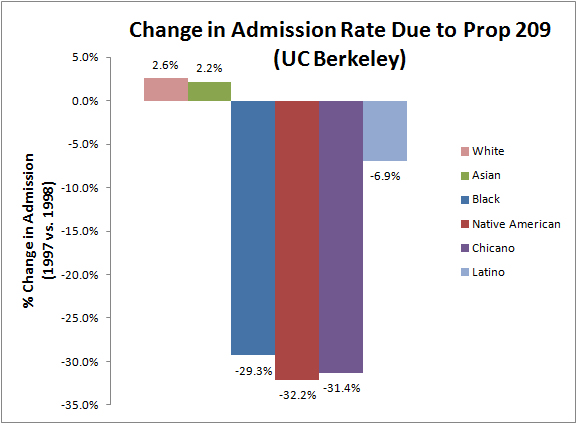
And before you can theorize it: no, Prop 209 did not significantly improve the “quality” of the students admitted into the UC system. According to data published here, graduation rate has been steadily improving over the last twenty years throughout the UC system, with little impact of Prop 209 on that trend.
The real impact of Prop 209? If you go to school in California, you are entering into an academic environment that is profoundly not diverse. Here is the demographic breakdown of the freshman class of 2010 across the entire UC system.
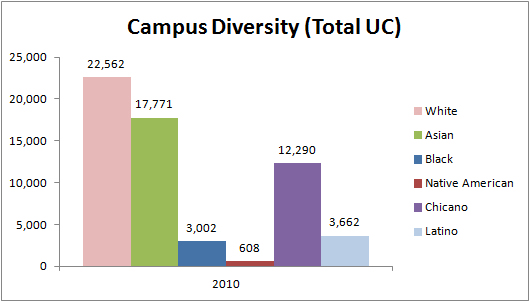
And this last graph is problematic because a diverse campus produces quantifiable improvements to the quality of higher education for students.
So what’s the take-home message? Prop 209 has produced extremely limited increase in Asian American admission rates in the last 15 years, but nothing really to write home about and certainly has helped the admission rates of White students the most. In the meanwhile, it has dramatically reduced the admission rates of Black, Native American, and Latino students.
Sadly, the UCOP report from which these numbers were taken did not include comprehensive disaggregated data for the Asian American community for this time period, but it’s extremely likely that similar trends that we see for Black, Latino and Native American students would be seen for Southeast Asian Americans or Pacific Islanders. If you are an Asian American worried about admission to the UC system, the biggest threat to your admission is not SCA5 and how it would restore race-based affirmative action to the UC system. The biggest threat to your admission is state-wide budget cuts.
As my graph of admission rates in the Total UC system shows, admission rates have plummeted for all racial groups in the last three years. These state-wide budget cuts have severely dropped the number of in-state spots available for students of any race, including Asian Americans, in favour of out-of-state or international applicants.
So, in summary, if you’re worried about your kids getting into the UC school system, you should be advocating for more funding for state universities, not against affirmative action.
(Correction: A previous version of this post apparently forgot to include all the Chicano numbers in the graphs. I apologize for the oversight.)
Update: Going through my archives, I found this great quote from a report on affirmative action issued by Susan Kaufmann, Associate Director for the Center for the Education of Women at the University of Michigan on the effect of Prop 209 in California that I had included in a post I wrote four years ago when affirmative action was being voted on in Arizona:
Prop. 209 has resulted in the elimination of services such as college preparation programs for students of color, summer science programs for girls, outreach to minority- and women-owned businesses to notify them of government contracting opportunities, and funding for training of minority professionals in fields where they are underrepresented. It has ended the requirement that state boards reflect the population of the state and also ended numerous voluntary K-12 school integration efforts. It has led to significant decreases in government contracts awarded to minority- and women-owned businesses, hiring of minority and female university professors, and the percentages of women and minorities working in the construction trades. In addition, it has led to decreases in the percentages of African Americans and Native Americans enrolled in the University of California system and apparently to similar decreases in the California State University system.


